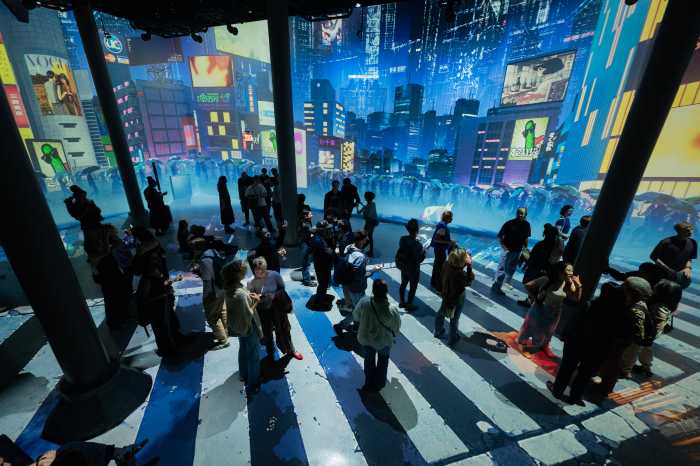Fashion has always loved to flirt with the Renaissance; Padina Bondar raids its workshop.
She lifts the logic of the quattrocento—resourcefulness, revision, reverence—and welds it to a present tense that refuses waste. The result is a collection that does more than blur the line between canvas and couture; it dissolves it, then redraws a new border in gold leaf.
The premise is audacious in the sweetest way. Each piece begins with the orphans of culture—thrift-store paintings, abandoned prints, textile remnants—rescued from the edge and reimagined as luxury. Materials are salvaged from the unglamorous places we pretend not to see, then revived through tattooing, painting, and embroidery until they move with the authority of haute dressmaking. hems whisper; lacquered appliqués catch light like varnish; seams hold the memory of other lives.
These are living works—garments with pulse and provenance—fusing the spirit of the old masters with the lineage of iconic couturiers.
Bondar’s discipline is the hinge that keeps this from tumbling into costume. Proportions stay exact; silhouettes speak in complete sentences. A graphite column interrupted by a single horizon line of paint; a razor-cut jacket corseted at the core and edged in hand-inked stitch; a trench with one salvaged panel set like a relic—framed by severe tailoring, never overwhelmed by it.

Visible repair becomes ornament, a quiet confession worn proudly on the outside. The clothes seduce first and sermonize later, which is to say they actually persuade.
Enter Kozo—painter, tattoo artist, and master of the palimpsest—whose body of work binds skin, canvas, and cloth into a single visual vocabulary.
His studio practice treats the tattoo machine like an etcher’s burin: lines laid with absolute conviction, color feathered in glazes, negative space kept sacred. On the body, his marks breathe with the wearer; on textiles, they anchor Bondar’s silhouettes with a controlled, almost liturgical intensity.

The much-admired collaboration with Maison Margiela proved how naturally his graphic language converses with couture—ink becoming architecture, intimacy scaled up to runway. Here, that same precision is integrated rather than appliquéd: Kozo’s ghosted brushwork appears as under-prints that read like fresco coming through plaster; his linework maps itself to darts and seams so the garment moves as a drawing in four dimensions. It is a Renaissance proposition by other means: form and spirit united, virtue visible in the join.
The Renaissance knew something we keep forgetting: that salvage is not scarcity, it is strategy. Spolia rebuilt cities; fragments were folded into new temples and new lives. Bondar resurrects that ethic for an age choking on surplus. Nothing here is “recycled” as an apology. It is re-consecrated.

Sustainability shifts out of penitence and into pleasure, which is where it belongs if we expect desire to do the heavy lifting. This is couture with a conscience that doesn’t scold—proof that responsibility can shimmer.
Context matters, and DTR Modern Gallery supplies it with a curator’s spine. Since opening its first location in 2003, DTR has built one of the East Coast’s most formidable gallery operations, with brick-and-mortar footprints in Boston, New York City, Washington, DC, and Palm Beach. The program’s fluency—modern masters through post-war alongside emerging, mid-career, and blue-chip estates—means real access: to studios, to archives, to the lifeblood of provenance.
Collectively, its veteran team brings over 125 years of combined experience to connoisseurs and new collectors alike. That pedigree matters here. Bondar and Kozo do not arrive as charming interlopers; they enter a lineage that knows how to hold weight.

The staging will read like a living studiolo—frames at human scale, rotating platforms, curated furniture that choreographs the viewer’s path. Models won’t simply walk; they will circulate, pivot, and edit the room with their movement. Every step becomes a brushstroke, every pause a curatorial decision. If the tempo lands, the rarest NYFW sensation follows: encounter rather than content.
There is romance in the craft, yes, but it is an unsentimental romance—sharp, adult, and clear-eyed about the world that made these materials disposable. The collection argues for a different economy of beauty: one where the past is not a costume closet, where wounds are not weaknesses but filigree, where transformation is not a trend but a working method. Fashion, at its highest register, has always been a system for moving meaning through time. This collaboration treats that truth with the seriousness of a love affair.
Call it a pageant for the future staged with the discipline of the past. Call it a séance for lost textiles that return as queens. I will simply call it necessary—and exquisitely so.







































